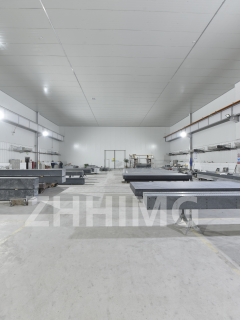If you are in the manufacturing industry or if you are dealing with highly precise machinery, then you know how important it is to maintain the precision of your equipment. Precision linear axis granite is an important component that needs to be well-maintained to ensure that the machinery it is a part of functions properly. However, over time, the appearance and precision of precision linear axis granite can be damaged. In this article, we will discuss how to repair the appearance and recalibrate the precision of damaged precision linear axis granite.
What is precision linear axis granite?
Before we go into how to repair the damages to precision linear axis granite, it is essential to understand what it is and its importance. Precision linear axis granite is a granite block that is used for precise measurements and movements in machinery. It is typically used in the manufacturing industry, especially in machines that require a high level of accuracy and precision, such as CNC machines.
Why is maintaining the appearance and recalibration of precision linear axis granite important?
Maintaining the appearance and recalibration of precision linear axis granite is essential for two reasons. Firstly, it ensures that the machinery in which it is placed functions accurately and precisely. Even minor damage to the granite axis can cause a significant shift in the accuracy of the machinery, which can result in substandard products or, at worst, cause the machinery to malfunction. Secondly, the appearance of the granite axis block can give you a clue about its function. If it appears worn out or damaged, it could mean that the machinery is either not being properly maintained or not being used correctly.
How to repair the appearance of damaged precision linear axis granite?
To repair the appearance of damaged precision linear axis granite, you will need to clean the granite block thoroughly and then remove any chips or scratches that exist on its surface. Here are the steps to follow to achieve this:
1. Clean the granite block: Use a soft-bristled brush to remove any dust and debris that have accumulated on the surface of the granite block. Next, use a damp cloth to wipe the surface of the block.
2. Remove any chips: If there are any visible chips on the surface of the granite block, use a small chisel or grinding tool to carefully remove them.
3. Remove scratches: The surface of the granite block is very hard. Therefore, you can use diamond cutting and polishing tools to remove scratches. If the scratches are more than superficial, the granite block needs to be resurfaced.
3. Polish the surface: After repairing any damage, use a polishing compound to buff the granite block until it is completely smooth. Alternatively, use an automatic polishing machine.
How to recalibrate the precision of damaged precision linear axis granite?
Recalibrating the precision of damaged precision linear axis granite requires some specialized tools. You will need a precision level and set of gauge blocks. Here are steps to follow to recalibrate the precision of your granite block:
1. Clean the granite block: As before, use a soft-bristled brush to remove any dust and debris that have accumulated on the surface of the granite block. Next, use a damp cloth to wipe the surface of the block.
2. Check the parallelism: Use a precision level to check the parallelism of the block.
3. Check the flatness: Check the flatness of the block using a set of gauge blocks. Place the gauge blocks on the surface of the block and take measurements to identify any deviation from flatness.
4. Adjust as necessary: If any deviation from parallelism or flatness is identified, adjust it as necessary. Use shims to adjust the parallelism as needed, and follow the manufacturer's instructions for any other adjustments.
5. Recheck the levelness and flatness: After making adjustments, recheck the levelness and flatness of the block to ensure that it has been properly recalibrated.
In conclusion, maintaining the appearance and recalibration of precision linear axis granite is crucial for ensuring that machinery functions accurately and precisely. Repairing any damage it has sustained can be an involved process, but it is necessary for maintaining the longevity and accuracy of the equipment it supports. By following the steps outlined above, you can restore the appearance and recalibrate the precision of your damaged precision linear axis granite quickly and efficiently.
Post time: Feb-22-2024

